This year is our second time experiencing the Sakura Season, or Cherry Blossom Season, living in Japan. It is a beautiful but hectic time to visit Japan, so here are our top tips for seeing the Cherry Blossoms in and around Tokyo.
Top Sakura Spots in Tokyo
Ueno Park
One of Tokyo’s most famous cherry blossom spots. Over 1,000 sakura trees line the central pathway, making it ideal for large hanami (cherry blossom viewing) gatherings. However, it can get very crowded, so it’s best to visit early in the morning or on weekdays for less crowds.
Shinjuku Gyoen
My personal favorite during Cherry Blossom Season, entry reservations must be arranged ahead of time. Which is actually a very good thing because it means the park is not as overcrowded as other popular Sakura locations. While there’s an entrance fee of about 500 yen, the peaceful atmosphere and variety of sakura make it worth the cost.
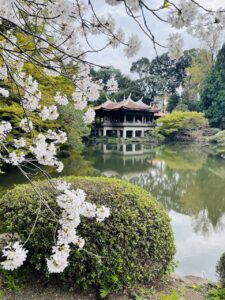
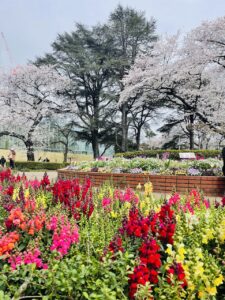
Chidorigafuchi
This spot along the Imperial Palace moat is another popular choice due to the picturesque sakura trees draping along the sides of the river and couples floating along in rowboats. On the weekend, I found this to be the most crowded of any of the places we visited. Last year it was so overwhelming that we decided to skip it this year. However, if it is your first time to Cherry Blossom season in Tokyo, then I recommend going, but preferably on weekdays.

Yoyogi Park
Conveniently located near Harajuku and Meiji Shrine, you can make a day of exploring multiple spots after enjoying the sakura. It’s a huge spacious dog-friendly park, so if you have a pet you want to join you for hanami, Yoyogi is the perfect place.
The Meguro River
With over 800 sakura trees lining the canal, it makes for a perfect stroll during the day. Or at night lanterns illuminate the sakura. This year unfortunately they were super strict, not allowing visitors to stop on most bridges to take photos and turning off the lanterns at 8pm. Probably due to the increase of tourism they will continue to rigorously control the area.
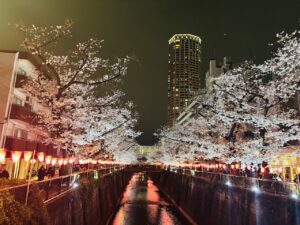
Great Sakura Day Trips from Tokyo
Chureito Pagoda
Located 2.5 hours by train from Tokyo, it is situated in Fujiyoshida, a city in Yamanashi Prefecture. This is where you go to get “the shot”. Offering one of the most iconic views of Mount Fuji, especially during cherry blossom season, it is understandably very popular. When we visited we had to wait in a one-hour-long line in order to enjoy our 5-minute-view at the top, of the Pagoda and Mount Fuji. Although far and crowded, I really feel it’s a must-do if you are visiting Japan for the first time. Also, we have visited at other times of the year and while typically full of visitors, I have only had to wait in line and experience a “time limit” during Sakura Season.
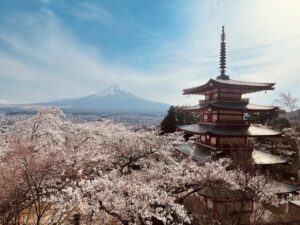
Lake Kawaguchiko
A popular getaway from Tokyo, Lake Kawaguchiko provides a beautiful view of Fuji along with many fields of flowers and onsens (hot spring baths) to enjoy. In spring, cherry blossoms bloom along the lake, especially near Ubuyagasaki and Oishi Park. Summer brings lavender fields during the Kawaguchiko Herb Festival. In autumn theres colorful foliage around the Maple Corridor. And in winter skies are the most clear and you can enjoy stunning views of snow-capped Mount Fuji.
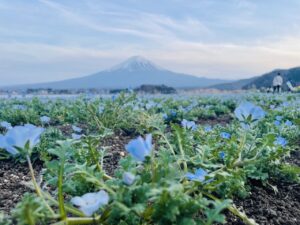
Kawagoe
A town about an hour from Tokyo, it is known for its historic Edo-era styled buildings. The sakura trees line the Shingashi River. Kawagoe is also famous for its sweet potato treats.
Mount Takao
Just an hour from Shinjuku, Mount Takao is the perfect hiking getaway from the busy city life in Tokyo. You can take a cable car to the summit and enjoy views of sakura along the trails. Its very steep going up but makes for a nice hike down through the blooming trees. I also highly recommend visiting in the Autumn to enjoy the changing foliage.

Satte Gongendo Park
Located around 1.5 hours from central Tokyo, it’s famous for its sakura tunnel. Rows of sakura trees arching overhead that are especially beautiful when combined with the vibrant yellow of rapeseed flowers in bloom.
Kamakura
Only an hour from Tokyo, Kamakura is a historic town filled with temples and shrines. Tsurugaoka Hachimangu Shrine, in particular, is one of the best spots for sakura viewing in Kamakura. Besides Sakura Season, it is a popular beach destination in summer for many Tokyo residents. We can’t wait to revisit in summer!

What Exactly is Sakura?
Sakura are ornamental cherry trees, particularly Prunus serrulata, native to East Asia. These trees are different from edible cherry trees because they don’t produce edible fruit. The most common variety in Japan is the Somei Yoshino, which has pale pink or nearly white flowers. Other varieties include Yaezakura (multi-petaled) and Shidarezakura (weeping cherry). Sakura are often referred to as “cherry blossoms” in English because they belong to the same Prunus genus as edible cherry trees.
The sakura bloom lasts only one to two weeks, a brief period that symbolizes impermanence in Japanese culture. This fleeting beauty makes sakura a powerful symbol of the transient nature of life.

Why Sakura Are Prevalent in Japan
Japan is home to many native cherry species, and the cultivation of sakura began in earnest during the Edo period. The spread of sakura across Japan became part of both urban and rural landscapes. Over the centuries, sakura trees have become deeply embedded in Japanese culture.
Sakura are seen as symbols of fleeting beauty in Japanese culture, tying into the Buddhist concept of mujō, the impermanence of all things. The samurai, in particular, associated sakura with their own way of life—brief yet beautiful, lived honorably and prepared to fall at any time.
Today, sakura are a national symbol of Japan. They appear in poetry, songs, and public celebrations.

Cherry Blossoms in Washington, D.C.
In 1912, Japan’s Mayor Yukio Ozaki gifted 3,000 cherry trees to Washington, D.C. The trees were part of a diplomatic gesture to strengthen U.S.-Japan relations. Some of the original trees still stand today, continuing to bloom each spring.
The National Cherry Blossom Festival, established in 1935, celebrates this gift. The festival has grown into one of the largest public events in the U.S., drawing millions of visitors each year.
The History of Hanami in Japan
Hanami, or cherry blossom viewing, has been a part of Japanese culture for over a thousand years. In the Nara period, plum blossoms (ume) were initially admired. By the Heian period, sakura had become the dominant flower for hanami, and the imperial court in Kyoto would hold poetry gatherings under the trees.
During the Edo period, sakura were planted widely across Japan, making hanami accessible to all. The Tokugawa shogunate encouraged the planting of sakura to promote unity and leisure for common people. Hanami became a festival with food, drink, and music, much like today.
Today, hanami is a nationwide event, with sakura bloom forecasts tracking the movement of the “sakura front” from the southern islands of Okinawa to the northern parts of Hokkaido.
Why Nature and Gardens Are Central in Japanese Culture
In Shintoism, nature is sacred. Trees, rivers, and rocks are believed to be inhabited by kami, or spirits. This reverence for nature is reflected in Japan’s garden designs, which seek to create harmony with the environment.
Zen Buddhism, which emphasizes simplicity and meditation, also plays a significant role in Japanese attitudes toward nature. Zen gardens use rocks, gravel, and moss to symbolize mountains and rivers, promoting contemplation and peace.
Japan’s deep connection to nature is also influenced by its seasonal awareness. Each season is celebrated through festivals, food, and clothing, with cherry blossoms marking the arrival of spring.
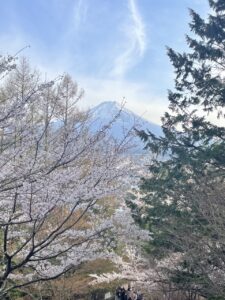
Sakura Season Across Japan
Sakura bloom times differ across Japan due to its diverse geography. In Okinawa, cherry blossoms begin blooming in mid-January, with a variety called kanhizakura that has deeper pink flowers. In the Kanto region, including Tokyo, sakura peak from late March to early April.
The bloom continues northward, reaching Hokkaido by late April to early May. Each region has its own unique sakura experience.
How Long Do Cherry Blossoms Last?
Sakura begin to bloom with “kaika” (first bloom), followed by “mankai” (full bloom) about 5-7 days later. Once fully bloomed, the flowers last around a week, depending on the weather. A storm or heavy rain can shorten this period significantly.
Although the cherry blossoms last only for 10-14 days, because of Japan’s geography, the sakura season spans about three months, from Okinawa’s January bloom to Hokkaido’s May bloom.
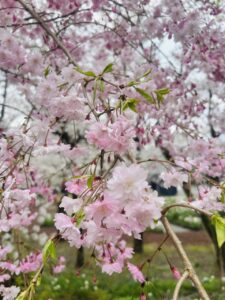
Why Are Allergies So Bad in Japan?
The pollen causing allergies in Japan is not from sakura, but from cedar and cypress trees. Many people suffer from hay fever, or kafunshō, which affects up to 40% of the population.
Cedar trees, planted widely after WWII, have matured and now release a lot of pollen. Cedar pollen peaks in late February to March, followed by cypress pollen in late March to April. By May, allergy season typically calms down, though grass pollen can still affect some people.In cities like Tokyo, pollen gets trapped by buildings and accumulates on concrete surfaces.
Locals use masks, antihistamines, and air purifiers to cope with the seasonal allergies.
Things to Know About Cherry Blossom Season
- Its expensive and crowded
- Allergies are terrible
- Sakura are very delicate only lasting a week or two
- If you want to experience a unique famous part of Japanese culture you need to do hanami at least once in your life
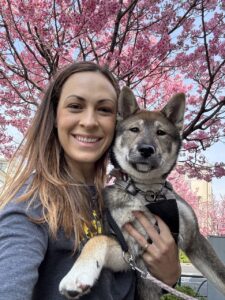
For more of our adventures check out these other posts:
What it’s like living in Japan
